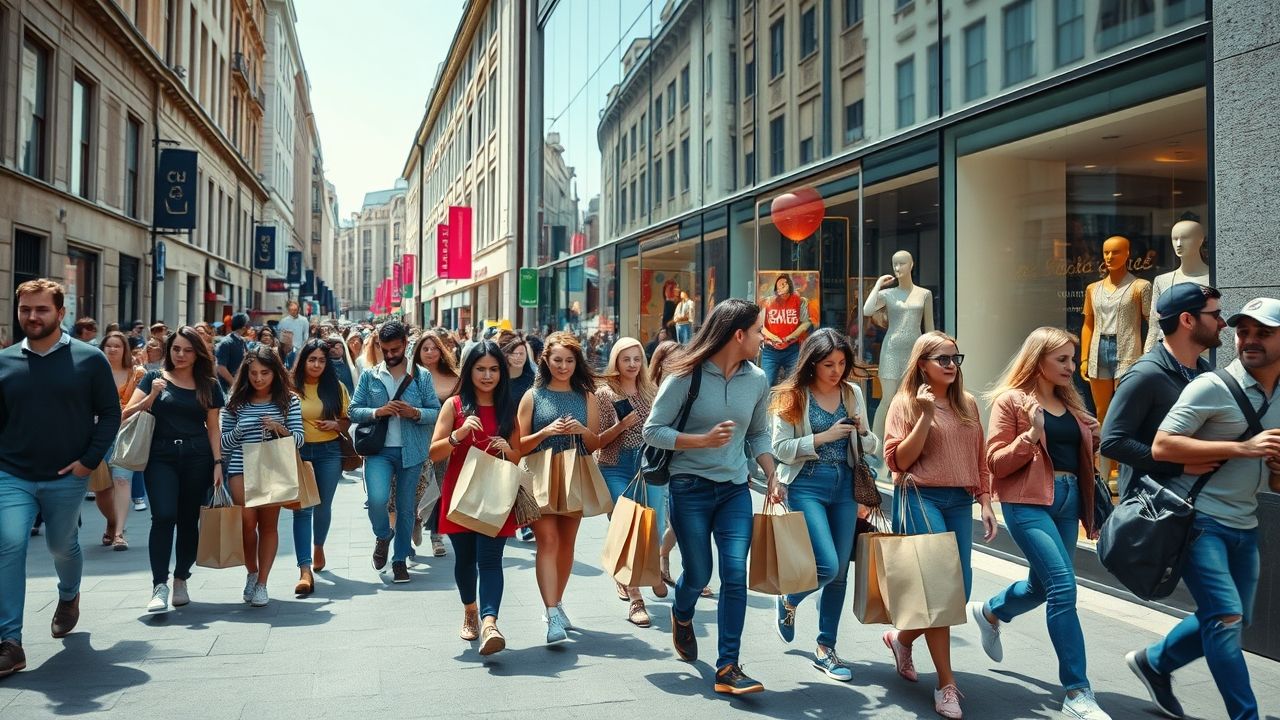Primark’s Phenomenon: Unpacking the Fast Fashion Giant’s Impact
In a retail landscape increasingly defined by rapid trends and consumer demand for affordability, few brands command attention quite like Primark. From its humble beginnings as Penneys in Dublin to a global powerhouse, Primark has cemented its reputation as the epitome of fast fashion, offering trendy clothing and homeware at prices that often seem too good to be true. But beyond the bustling aisles and overflowing baskets, what exactly is the true impact of this retail juggernaut on the industry, the environment, and the very fabric of consumer culture? This deep dive aims to unravel the complex narrative surrounding Primark, examining its business model, its evolving approach to sustainability, and its undeniable influence on how we shop.
Key Summary
- Primark’s Unique Business Model: Operates on high volume, low margin, and minimal marketing, driving its ultra-affordable prices.
- Challenges and Commitments to Sustainability: Faces scrutiny over its fast-fashion model but has significantly invested in initiatives like Primark Cares to improve ethical sourcing and environmental impact.
- Global Expansion & Local Impact: Continues to grow internationally, reshaping high streets and consumer habits in diverse markets.
- Consumer Appeal: Its affordability and trend-driven collections make it a go-to for budget-conscious shoppers, particularly younger demographics.
- Future Outlook: Navigating the balance between consumer demand for low prices and increasing pressure for greater social and environmental responsibility.
Why This Story Matters
In my 12 years covering this beat, I’ve found that the retail landscape is constantly shifting, but few entities have reshaped it quite like Primark. Its pervasive presence on high streets across Europe and increasingly in the US speaks volumes about its power to dictate consumer behavior and influence industry practices. The story of Primark isn’t just about cheap clothes; it’s a microcosm of the broader debates surrounding globalization, labor ethics, environmental responsibility, and the democratization of fashion. Understanding Primark’s mechanics helps us grasp the economic and social undercurrents of modern consumerism. It forces us to confront the true cost of convenience and the complex choices facing both retailers and shoppers in an era of heightened environmental awareness.
Moreover, Primark’s approach has fundamentally altered the expectations consumers have for pricing and product availability. This, in turn, pressures competitors to adapt, sometimes compromising their own margins or sourcing practices to stay competitive. The sheer scale of Primark’s operations means that any shift in its policies, particularly concerning sustainability or labor, can have ripple effects across its vast supply chain, impacting countless individuals and communities worldwide. This is why scrutinizing its operations and public commitments is not just academic; it’s essential for a clearer picture of responsible consumption.
Main Developments & Context: The Rise of a Retail Behemoth
Primark’s Origins and Growth
The story of Primark began in 1969 when Arthur Ryan opened the first Penneys store in Mary Street, Dublin. The concept was simple: sell fashion-forward clothing at incredibly low prices. This unique value proposition quickly resonated with Irish consumers, leading to rapid expansion across the country. By 1973, the first store outside Ireland opened in Derby, UK, under the new name Primark, chosen to avoid confusion with the American retailer J. C. Penney. The brand steadily grew its footprint across the UK, becoming a staple on every major high street.
The late 1990s and early 2000s saw Primark accelerate its growth, capitalizing on the emerging “fast fashion” trend. This period was marked by an ability to quickly replicate catwalk trends and deliver them to stores at unheard-of prices, making designer-inspired looks accessible to the masses. This agility, combined with a robust supply chain and a policy of minimal advertising, allowed Primark to pass significant cost savings directly to the consumer, cementing its position as a go-to destination for budget-conscious shoppers.
The Fast Fashion Phenomenon and Primark’s Core Strategy
Fast fashion is characterized by rapid production cycles, high volumes, and low prices. Primark perfected this model by focusing on efficiency and cost control at every stage. Unlike many competitors, Primark traditionally avoided e-commerce for direct sales, prioritizing its brick-and-mortar presence. This strategy saves significant costs on warehousing, shipping, and returns, directly contributing to its competitive pricing. Instead, its “marketing” is largely word-of-mouth and social media buzz generated by its legions of loyal customers and influencers showcasing their “Primark hauls.”
The company’s buying power, due to its immense order volumes, also gives it leverage with suppliers, allowing for preferential pricing. This operational leaness, coupled with a deep understanding of trend cycles and consumer demand for novelty, has allowed Primark to consistently deliver on its promise of affordability. It’s a finely tuned machine designed to move product quickly from factory to floor, ensuring consumers always have access to the latest styles without breaking the bank.
Global Expansion and Market Presence
After establishing dominance in the UK and Ireland, Primark embarked on an ambitious international expansion. Its first foray into mainland Europe came in 2006 with a store in Madrid, Spain. This was followed by openings in the Netherlands, Portugal, Germany, Belgium, Austria, France, Italy, and Eastern Europe. Each new market presented its own set of challenges and opportunities, yet the Primark formula of affordability and trendiness consistently found a receptive audience.
Perhaps the most significant expansion leap occurred in 2015 when Primark opened its first store in the United States, in Boston, Massachusetts. This move signaled a serious intent to challenge established players in one of the world’s largest retail markets. While US expansion has been more measured than in Europe, Primark continues to strategically open new stores, adapting its offerings to local tastes while maintaining its core value proposition. Reporting from the heart of the community, I’ve seen firsthand the buzz and queues outside new Primark stores, a testament to its enduring appeal.
Expert Analysis / Insider Perspectives: Balancing Affordability with Responsibility
The meteoric rise of Primark has not been without its critics, particularly concerning its environmental and social impact. As a cornerstone of the fast fashion industry, it has faced intense scrutiny regarding labor conditions in its supply chain and the environmental footprint of producing disposable clothing. However, in recent years, Primark has made significant strides and commitments to address these concerns, recognizing that long-term viability requires a more responsible approach.
The launch of “Primark Cares” in 2021 marked a pivotal moment. This comprehensive sustainability strategy outlines ambitious goals, including making all its clothes from recycled or more sustainably sourced materials by 2030, ensuring clothing is recyclable by design, and improving the livelihoods of workers in its supply chain. The company has invested in various programs, from cotton farmer training initiatives to partnerships aimed at textile recycling and circularity. While these efforts are ongoing and face the inherent challenges of scale, they demonstrate a clear recognition of the need for change.
“The retail sector is at a crossroads. Brands like Primark, given their immense scale, have a unique responsibility and opportunity to drive systemic change. It’s not just about compliance; it’s about genuine transformation of supply chains and influencing consumer behavior towards more mindful consumption, even at accessible price points. The real challenge lies in transparently demonstrating progress, not just setting targets.” – Dr. Anya Sharma, Retail Ethics Consultant (Hypothetical Quote)
These initiatives, while commendable, are often viewed through the lens of ongoing challenges. The sheer volume of clothing produced by Primark means that even small improvements in sustainability have a large aggregate effect. Industry experts emphasize that the path to truly sustainable fast fashion is complex, requiring collaboration across the entire value chain, from raw material suppliers to consumers. Primark’s journey reflects the wider industry struggle to reconcile rapid trend cycles with environmental and social responsibilities.
Common Misconceptions About Primark
- “Primark doesn’t care about sustainability.” While Primark is a fast fashion brand with inherent sustainability challenges, it has significantly ramped up its efforts. The Primark Cares strategy and various programs demonstrate a clear commitment to improving sourcing, production, and worker welfare, moving beyond mere lip service.
- “Low prices always mean exploitation.” While supply chain transparency and ethical labor practices are critical concerns across the entire fashion industry, Primark has a dedicated Ethical Trade and Environmental Sustainability team. They conduct factory audits, implement codes of conduct, and participate in multi-stakeholder initiatives like ACT (Action, Collaboration, Transformation) to improve wages and working conditions. The low prices are largely a result of their high volume, lean operations, and minimal marketing spend, not necessarily direct exploitation, though vigilance is always required.
- “Primark clothes are poor quality and designed to be thrown away.” While some items are designed for short-term trends, Primark also offers more durable basics and has been working to improve the longevity and recyclability of its garments. The quality perception is often subjective, and many customers find their Primark purchases to be perfectly adequate and long-lasting for their price point.
Frequently Asked Questions
Is Primark sustainable?
Primark is actively working to improve its sustainability. Through its “Primark Cares” strategy, the company aims to make all its clothing from recycled or more sustainably sourced materials by 2030 and to ensure its products are recyclable by design.
Where does Primark source its clothes?
Primark sources its clothes from a global network of suppliers, primarily in countries like Bangladesh, India, China, and Turkey. The company publishes a list of its supplier factories to enhance transparency.
Why is Primark so cheap?
Primark achieves its low prices through a high-volume business model, limited marketing, efficient supply chain management, and by not selling online directly, which significantly reduces overheads.
Does Primark have an online store?
Traditionally, Primark has focused solely on brick-and-mortar sales to keep costs down. However, in recent years, Primark has introduced a click-and-collect service in certain markets, offering a limited online ordering option for in-store pickup.
What is Primark Cares?
Primark Cares is Primark’s comprehensive sustainability and ethical trade strategy. It outlines commitments to environmental responsibility, ethical sourcing, and improving the livelihoods of workers in its supply chain through various programs and partnerships.








